
(a)
Interpretation:
The synthesis of given compound using a Claisen condensation is to be shown.
Concept introduction:
In Claisen condensation, ethyl ethanoate (ethyl acetate) is treated with sodium ethoxide, followed by acid work up, a
Answer to Problem 21.67P
The synthesis of given compound is shown below.

Explanation of Solution
The given compound is,
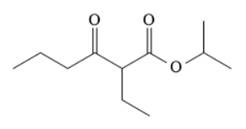
The disconnection of

The Claisen reaction in the forward direction would proceed as follows:

The Claisen and Dieckmann condensations are new
(b)
Interpretation:
The synthesis of given compound using a Claisen condensation is to be shown.
Concept introduction:
In Claisen condensation, ethyl ethanoate (ethyl acetate) is treated with sodium ethoxide, followed by acid work up, a
Answer to Problem 21.67P
The synthesis of given compound is shown below.

Explanation of Solution
The given compound is,
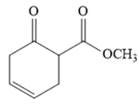
The disconnection of

The Dieckmann reaction in the forward direction would proceed as follows:

The Claisen and Dieckmann condensations are new
(c)
Interpretation:
The synthesis of given compound using a Claisen condensation is to be shown.
Concept introduction:
In Claisen condensation, ethyl ethanoate (ethyl acetate) is treated with sodium ethoxide, followed by acid work up, a
Answer to Problem 21.67P
The synthesis of given compound is shown below.

Explanation of Solution
The given compound is,
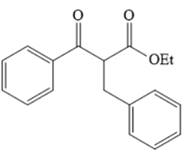
The disconnection of
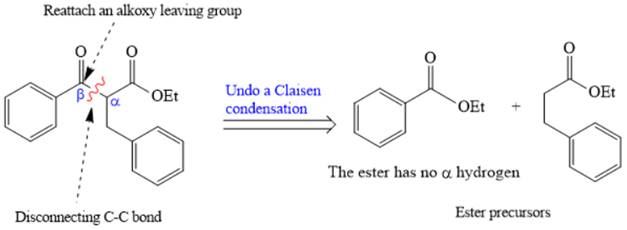
The crossed Claisen reaction in the forward direction would proceed as follows:

The Claisen and Dieckmann condensations are new
(d)
Interpretation:
The synthesis of given compound using a Claisen condensation is to be shown.
Concept introduction:
In Claisen condensation, ethyl ethanoate (ethyl acetate) is treated with sodium ethoxide, followed by acid work up, a
Answer to Problem 21.67P
The synthesis of given compound is shown below.

Explanation of Solution
The given compound is,
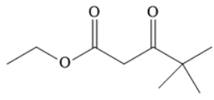
The disconnection of

The crossed Claisen reaction in the forward direction would proceed as follows:

The Claisen and Dieckmann condensations are new
Want to see more full solutions like this?
Chapter 21 Solutions
EBK ORGANIC CHEMISTRY: PRINCIPLES AND M
- Provide the reagents for the following reactions.arrow_forwardIf I have 1-bromopropene, to obtain compound Z, I have to add two compounds A1 and A2. Indicate which compounds are needed. P(C6H5)3arrow_forwardDraw the major product of this reaction. Ignore inorganic byproducts. Assume that the water side product is continuously removed to drive the reaction toward products. O CH3CH2NH2, TSOH Select to Draw >arrow_forward
- Indicate the products obtained by reacting fluorobenzene with a sulfonitric mixture.arrow_forwardIf I have 1-bromopropene, to obtain compound A, I have to add NaOH and another compound. Indicate which compound that would be. C6H5 CH3arrow_forwardIf I have 1-bromopropene and I want to obtain (1,1-dipropoxyethyl)benzene, indicate the compound that I should add in addition to NaOH.arrow_forward
- Draw the major product of this reaction. Ignore inorganic byproducts. Ο HSCH2CH2CH2SH, BF3 Select to Draw I Submitarrow_forwardFeedback (7/10) Draw the major product of this reaction. Ignore inorganic byproducts. Assume that the water side product is continuously removed to drive the reaction toward products. Incorrect, 3 attempts remaining Ο (CH3CH2)2NH, TSOH Select to Draw V N. 87% Retryarrow_forwardIf I want to obtain (1,1-dipropoxyethyl)benzene from 1-bromopropene, indicate the product that I have to add in addition to NaOH.arrow_forward
 ChemistryChemistryISBN:9781305957404Author:Steven S. Zumdahl, Susan A. Zumdahl, Donald J. DeCostePublisher:Cengage Learning
ChemistryChemistryISBN:9781305957404Author:Steven S. Zumdahl, Susan A. Zumdahl, Donald J. DeCostePublisher:Cengage Learning ChemistryChemistryISBN:9781259911156Author:Raymond Chang Dr., Jason Overby ProfessorPublisher:McGraw-Hill Education
ChemistryChemistryISBN:9781259911156Author:Raymond Chang Dr., Jason Overby ProfessorPublisher:McGraw-Hill Education Principles of Instrumental AnalysisChemistryISBN:9781305577213Author:Douglas A. Skoog, F. James Holler, Stanley R. CrouchPublisher:Cengage Learning
Principles of Instrumental AnalysisChemistryISBN:9781305577213Author:Douglas A. Skoog, F. James Holler, Stanley R. CrouchPublisher:Cengage Learning Organic ChemistryChemistryISBN:9780078021558Author:Janice Gorzynski Smith Dr.Publisher:McGraw-Hill Education
Organic ChemistryChemistryISBN:9780078021558Author:Janice Gorzynski Smith Dr.Publisher:McGraw-Hill Education Chemistry: Principles and ReactionsChemistryISBN:9781305079373Author:William L. Masterton, Cecile N. HurleyPublisher:Cengage Learning
Chemistry: Principles and ReactionsChemistryISBN:9781305079373Author:William L. Masterton, Cecile N. HurleyPublisher:Cengage Learning Elementary Principles of Chemical Processes, Bind...ChemistryISBN:9781118431221Author:Richard M. Felder, Ronald W. Rousseau, Lisa G. BullardPublisher:WILEY
Elementary Principles of Chemical Processes, Bind...ChemistryISBN:9781118431221Author:Richard M. Felder, Ronald W. Rousseau, Lisa G. BullardPublisher:WILEY





